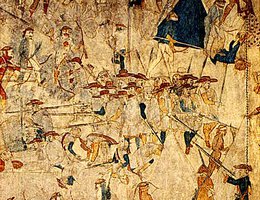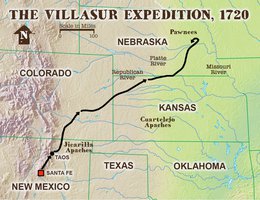

In the early 1700s, Spain claimed as their exclusive territory most of the Central Plains including Nebraska. They were very concerned with protecting their rights to what they saw as a potentially enormous trade with the Native Americans on the plains. But it had been a Frenchman, Bourgmont, who had reached the Platte first and who named it. And the Spanish in New Mexico were seeing more and more evidence of French trade with tribes like the Apache, who traveled north and south along the plains. In 1719 war broke out between France and Spain, and the government in New Mexico decided they had to counter French incursions into Nebraska.
Lieutenant-General Pedro de Villasur (pronounced vee-yah-SOOR) was appointed by Governor Valverde of New Mexico to lead a Spanish army into Nebraska and find out what the French were doing. Villasur had been in New Mexico a number of years and had acted as Valverde’s Lieutenant-Governor in 1719. He was undoubtedly a good administrator but had little military experience. He assembled approximately 40 soldiers and 60 to 70 Indian allies who were excellent skirmishers. He also recruited a dozen or so Apache to serve as guides. The Apache had been mauled by the Pawnee the previous year and were spoiling for revenge. The precise route that Villasur choose is unknown, but it apparently followed a hunting and raiding trail used by the Pawnee.

Joseph Naranjo (pronounced Nah-RAHN-ho) was one of Villasur’s principle aides. He was the son of an African father and Hopi Indian mother and was an experienced, skillful, and fearless explorer. By 1714, Naranjo apparently had made at least three trips to the Platte River area of Nebraska. The viceroy in Mexico City was so impressed that he ordered the governor of New Mexico to confer upon Naranjo the title "Captain of War." Naranjo acted as a scout, interpreter, and guide. He was also in charge of the Indian allies who assisted the Spanish forces.
Villasur’s expedition also included a trader who probably anticipated commercial opportunities on the trip because he loaded down six pack animals with trade goods. One Catholic priest, Father Fray Juan Minguez (pronounced MEEN-gase), also accompanied the expedition.
On the morning of June 16th, 1720, Villasur's expedition left Santa Fe. His main objective was to capture French fur traders who had entered Spanish territory illegally and discover their plans. His expedition was one of the most intriguing and disastrous events in our early history.